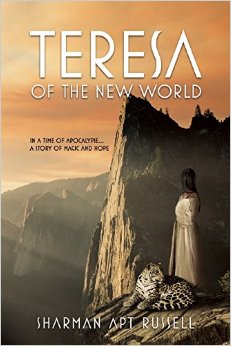 “TERESA OF THE NEW WORLD,” by Sharman Apt Russell, Yucca Publishing, March 3, 2015, Hardcover, $14.99 (young adult)
“TERESA OF THE NEW WORLD,” by Sharman Apt Russell, Yucca Publishing, March 3, 2015, Hardcover, $14.99 (young adult)
Sharman Apt Russell’s “Teresa of the New World” is unlike anything I’ve ever read. It’s unexpected and beautiful with a touch of grit and a good helping of magic.
Set in the 16th century, “Teresa of the New World” is the fictional account of Teresa, the daughter of real-life conquistador Cabeza de Vaca who shipwrecked in the New World in 1528. Over a period of eight years, Cabeza de Vaca lived as a slave, trader and shaman. He returned to Spain in 1537, was appointed governor of present-day Argentina in 1540 and returned to Spain again in 1545.
After being shipwrecked in the New World, Cabeza de Vaca was rescued and lived with a native tribe. “Teresa of the New World” opens when Teresa is a toddler. Teresa’s father sets out to find more conquistadors and decides to take his daughter with him. Teresa and her father travel from their tribe in Texas westward into the setting sun. During their journey, Cabeza de Vaca is seen as a holy man, performing miracles, having visions and making prophecies. But when they finally reach New Spain, everything changes.
Cabeza de Vaca is a married man — a married white man. Teresa, the daughter of a native woman, can’t be recognized as his daughter. Instead, she finds herself a kitchen servant in a Spanish official’s home. Cabeza de Vaca returns to Spain, and Teresa grows quiet; the magic — talking with the earth and animals — from her childhood disappears.
Teresa lives in silence, accepting her new circumstances the best she can. That changes when an outbreak of the measles devastates the area. The 16-year-old realizes she can now decide her own fate and sets off on her own journey. Along the way, she befriends a Spanish warhorse and a Mayan were-jaguar child who cannot control his shape shifting. These unlikely companions unite as they run from Plague — smallpox, measles, typhus and scarlet fever — who is stalking them at every turn.
Just when they think they’ve got the upper hand, the companions discover a dark force they’ve never encountered before has manipulated them. Desperate to save her companions and herself, Teresa turns to the magic she let go of and starts listening to the earth again, and it’s like returning home. Teresa sinks underground, swimming through rocks and fossils and manipulating faults. By embracing her past, Teresa guarantees herself a future.
“Teresa of the New World” is an excellent example of how magical realism can work. Sharman Apt Russell expertly blurs the lines between the known and unknown, making it feel perfectly natural that Teresa can carry on a conversation with the earth.
While Cabeza de Vaca is an interesting character, it’s Teresa, the fictional character, that you find yourself wanting to know more about. What would it be like to be born into a tribe and taken as a toddler from your home by your Spanish father? How would his beliefs mixed with those of other native peoples shape your life and beliefs? What would happen when everything you’ve known changes with the drop of a hat? Russell explores all these questions and more, giving a character sketch much more detailed and nuanced than found in the majority of YA fiction available today.
I finished “Teresa of the New World” with mixed feelings. I find myself continually thinking about the book and yet, I’m not sure that I would call it a favorite. It’s hard to explain these mixed feelings. I’m certainly glad I read it, but would I reread it? Maybe, but not for a long while. It needs to percolate and be revisited with fresh eyes.
